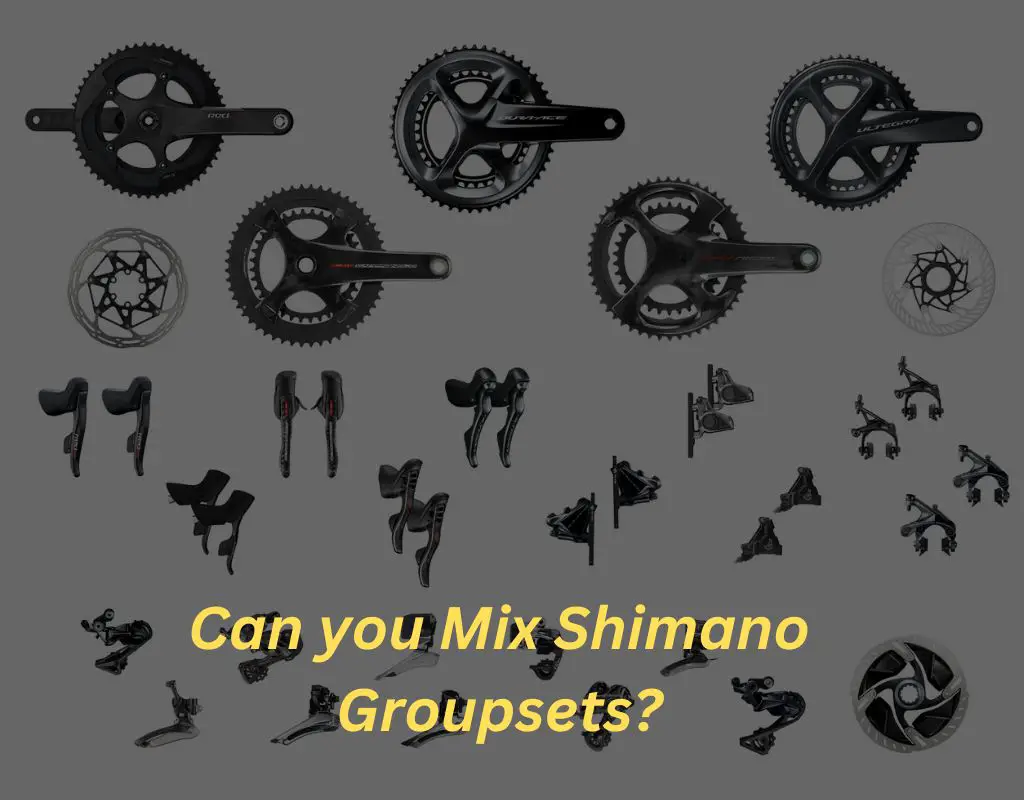
If you are a cyclist who likes to customize your bike, you may have wondered if you can mix Shimano groupsets. Shimano is one of the leading manufacturers of bicycle components, and they offer a range of groupsets for different levels of performance and budget.
What is a Groupset?
A groupset is a collection of parts that work together to control the shifting and braking of your bike, such as the derailleurs, shifters, brakes, chain, cassette, and crankset.
Shimano groupsets are designed to work best when used as a complete set, but sometimes you may want to mix and match different parts from different groupsets.
For example, you may want to upgrade some parts of your existing groupset, or you may want to use a different cassette size or crank length for different terrains. Or maybe you just like the look of a certain part from another groupset.
Can you mix Shimano Groupsets?
The answer is not so simple, as it depends on several factors, such as the speed, generation, and type of the groupsets you want to mix.
Here, we will explain some of the main considerations and guidelines for mixing Shimano groupsets, but keep in mind that this is not an exhaustive list and there may be exceptions and variations depending on your specific setup.
Speed
One of the most important factors to consider when mixing Shimano groupsets is the speed of the components. The speed refers to the number of gears or sprockets on your cassette, which determines how many steps or clicks your shifter has to move the chain across the cassette.
Shimano offers groupsets with different speeds, ranging from 6 to 12, depending on the level and type of the groupset.
Importance of Matching Component
You should not mix components with different speeds, as they are not designed to work together and may cause shifting problems or damage.
For example, if you try to use a 10-speed shifter with an 11-speed cassette, the shifter will not have enough clicks to cover all the gears on the cassette, and the chain will not align properly with the sprockets.
Similarly, if you try to use an 11-speed shifter with a 10-speed cassette, the shifter will have one extra click that will not correspond to any gear on the cassette, and the chain will be too narrow for the sprockets.
Exceptions to Speed Matching
There are some exceptions to this rule, such as using a 10-speed shifter with a 9-speed cassette or vice versa, which may work with some minor adjustments or modifications. This is not recommended by Shimano and may void your warranty or compromise your safety. Therefore, it is best to stick to components with the same speed when mixing Shimano groupsets.
Generation
Another factor to consider when mixing Shimano groupsets is the generation of the components. The generation refers to the model year or version of the groupset, which indicates how new or old it is.
Shimano updates its groupsets periodically with new features or improvements, and sometimes these changes affect the compatibility or performance of the components.
Shimano introduced a new cable pull ratio for its 11-speed road groupsets in 2015 (known as 11-speed 5800/6800/9000), they have a different amount of cable movement for each shift compared to previous 11-speed road groupsets (known as 11-speed 4700/6700/7900).
This means that you cannot mix shifters and derailleurs from different generations of 11-speed road groupsets, as they will not shift correctly or smoothly.
Compatibility Across Generations
Some components from different generations may still be compatible or interchangeable, such as cassettes, chains, cranksets, or brakes.
You can use a 10-speed cassette from any generation of 10-speed road groupsets with any 10-speed shifter and derailleur from any generation of 10-speed road groupsets.
Still, you should always check the specifications and compatibility charts from Shimano before mixing components from different generations.
Related: Is Shimano Ultegra Good?
Pros and Cons of Mixing Shimano Groupsets
Pros of mixing Shimano groupsets
Save Money
Mixing Shimano groupsets can help you save money by allowing you to reuse some of the parts you already have, or buy cheaper parts that are compatible with your existing ones.
For example, if you have a Shimano 105 groupset and you want to upgrade to Ultegra, you don’t have to buy the whole Ultegra groupset. You can just buy the Ultegra shifters and derailleurs, and keep using your 105 brakes, chain, cassette and crankset.
This way, you can enjoy the improved shifting performance of Ultegra without spending too much money.
Upgrade Ggradually
Mixing Shimano groupsets can also help you upgrade gradually by allowing you to replace some of the parts over time, rather than all at once.
Consider having a Shimano Tiagra groupset and you want to upgrade to 105, you can start by replacing the shifters and derailleurs first, then the brakes later, then the chain, cassette and crankset last.
Create a Unique Combination
It can help you create a unique combination that suits your riding style and preferences. A road cyclist who likes to climb hills might mix a Shimano Dura-Ace rear derailleur with a Shimano GRX front derailleur and crankset.
Because the Dura-Ace rear derailleur is known for its smooth shifting and precise indexing, while the GRX front derailleur and crankset are designed for wider tire clearance and better performance on rough terrain.
Cons of mixing Shimano groupsets
Compatibility issues
Mixing Shimano groupsets can cause compatibility issues that may affect the performance or functionality of your bike. Mixing different generations or series of Shimano groupsets, such as 10-speed with 11-speed or road with mountain bike, may encounter problems such as chain skipping, poor shifting quality, brake rubbing or cable tension mismatch.
To avoid these issues, make sure that the parts you mix have the same speed (number of gears), cable pull ratio (amount of cable movement per shift) and mount type (how they attach to the frame or handlebar).
Reduced performance
It can also reduce the performance of your bike by creating inefficiencies or inconsistencies in the system.
Consider mixing different levels of quality or technology of Shimano groupsets, such as Dura-Ace with Sora or Di2 with mechanical, you may experience problems such as increased weight, suboptimal shifting performance, and less precise gear changes.
Read Also: Why Shimano is Expensive?
Conclusion
It is possible to mix some Shimano groupset components; it requires careful consideration and adherence to compatibility guidelines.
Mixing groupsets can offer cost-saving opportunities, gradual upgrades, and the ability to create a custom setup to suit your riding preferences.
Though, it’s crucial to be aware of potential compatibility issues and reduced performance that may arise from combining components from different generations or levels of Shimano groupsets.
Thorough research and understanding are essential to ensure a successful and satisfying outcome when mixing Shimano groupsets.
